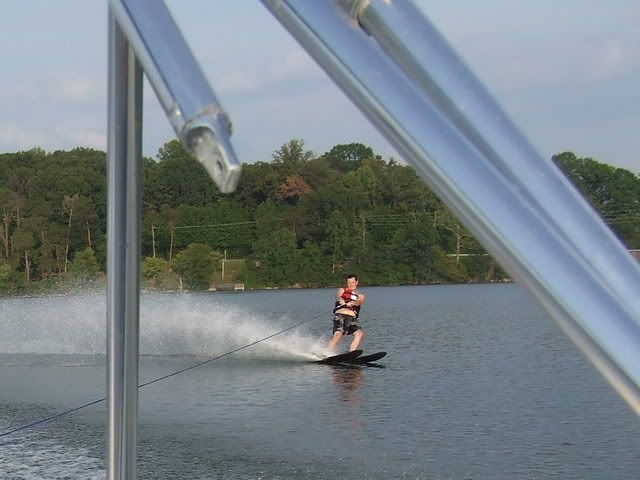Re: Are two skiis for learning or do ppl stay on 2??
Great writeup, Frank...on how to learn to drop one and progress from 2 to 1. I agree with 90% of it, but I'll offer one alternative/counterpoint to consider for deepwater starts if someone is struggling:
On deepwater starts, I was never able to understand how some people could start with the back foot out of the toehold as you suggest. It feels more unstable and uncomfortable for me, and puts a lot of strain on that one knee. BUT, I have heard this from others many times before, so I know your method obviously works for you as it does for many others.
But personally, even when first learning, I always very much preferred to have both feet in the binding/toe hold for deepwater starts. That way I can do that "squat" to a standing position using BOTH legs/knees, and I have found it much easier to keep the ski straight and stable when you have two legs to leverage it.
So I'd recommend you try it both ways (back foot in, and back foot out), and see which might feel more comfortable for you and go with that.
When I coach and teach people how to do deepwater slalom starts, I usually just tell them to concentrate almost exclusively on 3 simple things:
1. Stay squatted...tuck that ski as close to your body as possible, as close as you can get to nearly sitting your butt on the back of the ski.
2. Arms straight...stretched out toward the tip of your ski. Do NOT do anything to pull back against the pull of the boat. You need to just sit there in that tucked position with arms straight no matter HOW hard the boat is pulling.
3. WAIT for the boat to gain enough speed to completely plane your ski out before you try to deviate from points 1 or 2. Because if you stand too early, or if you start to pull that handle toward your body (natural to do when you're under a pull) you'll just plow more water, get more tired getting up, and become unstable.
You need to just sit there and let the boat pull you. There is absolutely nothing to gain and only energy to lose when you try to pull back against the boat. This is especially critical when you have a slow/underpowered boat that might be dragging your tail for 100 yards while it winds up to power.
The other big reason I always put both feet in the bindings for deepwater starts is because I now slalom exclusively on a full double-boot ski. And anyone who may want to progress to such a ski will need to know how to deepwater with both feet locked in. 'Cause if someone is able to start with one foot out and put their rear foot into a double-boot...well...I wanna meet that guy! I can barely get my feet in my very very snug double boots while just floating in the water!
Occasionally now when I go on a friends boat and open-water ski without my own ski I grab one of theirs, which invariably just has a rear toehold...it feels mighty awkward to me and my heel walks all over the place at first, but I can adjust to it pretty quick. But no question I've grown to become quite reliant on having both feet completely locked in over the years...
And let me throw one last tip out there for learning any watersport in general that I feel is absolutely critical and too often not mentioned...whether you're dropping a ski, or deepwater starting, or tooling along happily on the surface trying to keep your balance, one, two, or wakeboarding. STOP LOOKING DOWN AT YOUR SKI AND AT THE WATER! Keep those eyes forward at ALL times. Look at the boat, at the shore, at your lovely spouse, look ANYWHERE else but down. When you look down, you have less balance no matter what you're doing...walking, bike riding, anything. Have you ever seen a tight rope walker or an Olympic balance beam competitor look down at their feet? NEVER! Because if they did, they'd get wobbly and possibly fall. Beginners always tend to look down by nature and they need to get past this. So keep your eyes forward at ALL times. This will help with everything in these sports...crossing wakes, dealing with rough water, and anything else that might lead you to being unstable. Usually you'll go where your eyes go, and if your eyes go down to look at the big honking wake you're about to hit, you're probably going down too!
Anywho...maybe these tips, in conjunction with Franks excellent write-up, will help someone now or later on their deepwater slalom starts. Happy boating!





















